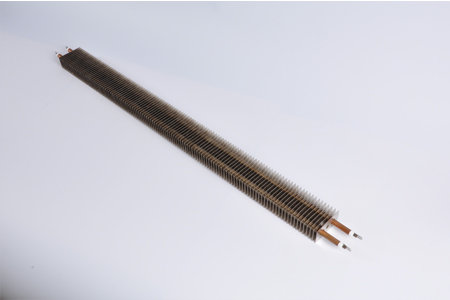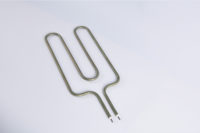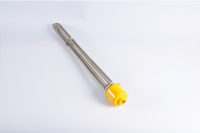♠ Confirm the surface load of the electric heating tube.
- Definition of Surface Load: Surface load refers to the number of power per unit area on the surface of the heating element, expressed in W/cm2.
- Formula for calculating surface load: Power (W)/[tube diameter (cm)*3.14*L (cm)], L refers to the total length of heating zone of electric heating tube)
♠ Confirm the working environment of electric heating elements.
- Liquid heating
As the electric heater in water heating, such as the flange water heating tubes used for the water tank, its surface temeprature can be absorbed quickly by the liquid. So, it can not be very intuitive to estimate the surface temperature of the electric heating elements.
2. Air Heating
(1) Static air
It is simple to estimate the surface temperature when heated in static air, just like the electric cartridge heater for moulds’ using.
- The surface load is 1W/cm2… The surface temperature can reach 300 degrees celsius.
- The surface load is 2W/cm2… The surface temperature can reach 420 degrees celsius.
- The surface load is 3W/cm2… The surface temperature can reach 500 degrees celsius.
- The surface load is 4W/cm2… The surface temperature can reach 580 degrees celsius.
- The surface load is 5W/cm2… The surface temperature can reach 630 degrees celsius.
- The surface load is 4W/cm2… The surface temperature can reach 680 degrees celsius.
(2) Floating air
Heating in flowing air, like a duct heater, the relationship between surface load and surface temperature varies with different wind speed, so estimating the surface temperature of an electric heater is a little more complicated than in a static air heater.
- When the wind speed is 3m/s, the surface temperature of the heating tube can reach to 140 degrees, 270 degrees, 360 degrees and 440 degrees respectively when the surface load of the heating tube reaches to 1W/cm2, 2W/cm2, 3W/cm2 and 4W/cm2.
- When the wind speed is 3m/s, the surface temperature of the heating tube can reach to 110 degrees, 200 degrees, 280 degrees, 330 degrees, 395 degress and 440 degrees respectively when the surface load of the heating tube reaches to 1.2W/cm2, 2W/cm2, 3W/cm2 , 4W/cm2, 5W/cm2 and 5.7W/cm2.
- When the wind speed is 3m/s, the surface temperature of the heating tube can reach to 100 degrees, 150 degrees, 210 degrees, 280 degrees, 310 degress and 360 degrees respectively when the surface load of the heating tube reaches to 1.4W/cm2, 2W/cm2, 3W/cm2 , 4W/cm2, 5W/cm2 and 5.7W/cm2.
- When the wind speed is 3m/s, the surface temperature of the heating tube can reach to 110 degrees, 120 degrees, 180 degrees, 230 degrees, 280 degress and 330 degrees respectively when the surface load of the heating tube reaches to 1.8W/cm2, 2W/cm2, 3W/cm2 , 4W/cm2, 5W/cm2 and 5.7W/cm2.
These technical dates are just for reference when designing the electric heaters, actual performance depends on specific conditions of heating area. Anyway, hope these information can help you in something.



Leave A Comment